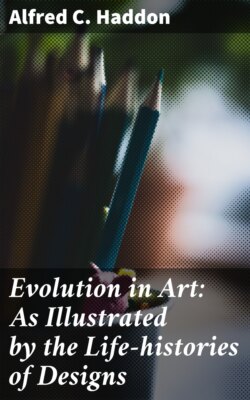Читать книгу Evolution in Art: As Illustrated by the Life-histories of Designs - Alfred C. Haddon - Страница 18
На сайте Литреса книга снята с продажи.
V.—The Massim District.
ОглавлениеTable of Contents
The country at the extreme south-east end of New Guinea round Milne Gulf, together with the neighbouring groups of islands, constitutes a natural province to which I have proposed to extend the name Massim. For the history of this term the reader is referred to Professor Hamy’s paper, “Étude sur les Papouas de la Mer d’Entrecasteaux” (Rev. d’Ethnogr., vii., 1888, p. 503). The various archipelagoes which collectively constitute this district are—(1) The Moresby Group, including all the islands between Milne Gulf and Wari (Teste Island); (2) the Louisiade Group, including Misima, Tagula (Sudest), and all neighbouring islands; (3) the D’Entrecasteaux Group, including Duau (Normanby Island), Goodenough, and the other islands; (4) the Trobriand Group, the largest island in which is Kiriwina; and (5) the Woodlark Group (Murua, etc.), and including Nada (the Laughlan Islands). There is a considerable amount of indigenous trade between these islands. For example, the Nada folk make annual trading voyages to Murua to exchange coco-nuts for taro. Dr. Finsch says (Samoafahrten, 1888, pp. 207-209), “A great many objects (such as the beautiful lime calabashes) are bartered from the Woodlark Islands, the inhabitants of which with their large sea-going canoes undertake extensive trading voyages.... At all events Trobriand is visited from Normanby, Welle [a small island close by the latter] and Woodlark Islands, for the Trobrianders themselves probably do not undertake trading voyages.” In describing the manufacture of earthen pots at Wari (Teste Island), Finsch says (Samoafahrten, p. 281) the upper border of these pots “exhibits various simple band patterns which are scratched with fork-like bamboo instruments, and which serve not for ornament but as trade marks. Thus here also each woman has her own mark with which she signs her fabrication. The pottery has an extended sale as far as the D’Entrecasteaux and to Chads Bay, South Cape, Woodlark Island, and perhaps also to the Louisiades.” In my Memoir (p. 223) I have included a MS. description of the manufacture of pottery in the same island, which was kindly placed at my disposal by Dr. H. O. Forbes, and I also copied Dr. Forbes’ sketches. (Fig. 23.) The Wari people have to import wood for their houses, and also, like the natives of the Engineer Group, who are great traders, they procure canoes from Pannaet (Deboyne Island). Owing to the trading which occurs amongst these islands and with the mainland, it is very difficult to determine from specimens of native work in European collections what style of work is characteristic of each of these groups, especially as comparatively few specimens are properly labelled. I have, however, but little doubt that each group has characteristic designs and forms, and possibly in some cases these may be peculiar to them.
